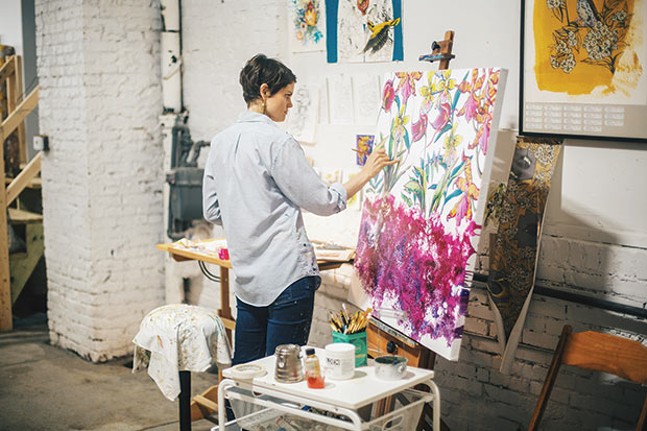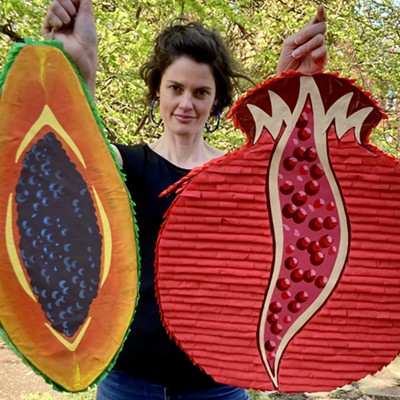Amphibians breathe air and water, so they register changes to the climate quicker and more acutely than other living creatures.
An example: Panamanian golden frogs, with a glow of fluorescent yellow and black spots, is now critically endangered and there have been no reported sightings of the frog since 2009.
The disappearance of this frog and several other species of amphibians has motivated the science community to act, and the momentum is spreading so quickly that even the art community is jumping on board.
This is where Ashley Cecil comes in.
She's a Pittsburgh-based artist who specializes in recreating scenes of flora and fauna on canvasses and through sculpture. Her art will be featured at her “Edged Out” opening reception on June 28 at the Frick Environmental Center in Squirrel Hill. She says amphibians are the perfect artistic vehicle to highlight an unfolding, worldwide extinction crisis.
“Some are drab and others look like you dunked them in a can of paint, ” says Cecil.
Those eye-popping colors — bright pinks, deep greens and vibrant blues — are prominently displayed in her work. Cecil’s canvasses spill out a rainbow of colors to keep viewer’s eyes locked in.
And once she has gotten your attention, Cecil hopes art lovers will think about more than the subject’s appearance and focus on the plight facing thousands of amphibian species today.
“These species are particularly vulnerable right now,” says Cecil. “Ponds drying up, or too much rain. That really affects them. They are bell-weathers for climate change.”
According to the United States Forest Service, amphibians are among the leading taxonomic groups threatened with losses due to climate change. Scientists believe their problems can be a precursor to humans’ problems; the frogs can serve as “canaries in coal mines” for climate change.
And, the populations of many frog species are already being devastated by the amphibian chytrid fungus disease. This disease has wiped out about 30 percent of the worldwide amphibian population. Cecil says the loss of amphibians should alarm us all since they play a vital role in many ecosystems.
“The ecosystem is like a chain link fence and when you remove a link, you disrupt the entire thing,” says Cecil.
Cecil says regular Pennsylvanians can do their part in saving amphibian species. She hopes her art inspires viewers to get out into the woods and become “citizen scientists.” Cecil says this can be as simple as learning frog calls to document species tallies. She says you don't have to have a master’s degree in biology to help.
“Art is a tool to engage people in science in a way that feels approachable,” says Cecil. “Any person can collect data for scientific purposes, whether you have been trained in the sciences or not.”
Her exhibit features exotic amphibians, as well as local species like the Northern leopard frog and wood frog. Portrait display cages are meant to symbolize how amphibians’ environments are closing in on them. One painting displays a rainforest landscape being dissected by neon-pink rectangles that represent how farmland is encroaching on natural places like the Amazon.
Cecil says her partnership with the University of Pittsburgh’s Richards-Zawacki Lab has been instrumental in helping her boil down scientific research. Portraying complex research studies in artistic form is no easy feat.
Cecil hopes her art specifically focusing on amphibians will help inspire more people to join the movement to combat the effects of climate change. She believes shifting our energy market from fossil fuels to renewable energy could help, particularly in the Southwestern Pennsylvania region.
“How can we, collectively, pivot and move away from harmful energy sources,” says Cecil. “We are not going to flip a switch, but I hope people make connection with how these energy sources are affecting the environment.”
But she believes her artwork can digest some of those more complicated climate-change issues for viewers. And she hopes her art inspires all people to realize the battle against climate change can be fought by anyone, anywhere.
“I kind of think that people think of topics like climate change as what scientist do and work on,” says Cecil. “But we need an all-hands-on-deck approach; we need everyone involved to resolve this.”
__
Ashley Cecil: Edged Out
June 28, 6-9 p.m. Frick Environmental Center, 2005 Beechwood Boulevard, Squirrel Hill




















